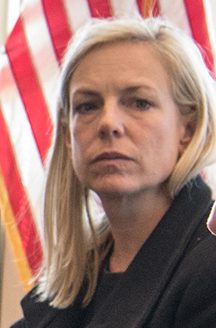
News and Commentary.
In an editorial published in the Washington Post, U.S. Department of Homeland Security (DHS) Secretary Kirstjen Nielsen painted a bleak picture of drone technology’s “dark side” and urged lawmakers to give the Department more powers to deal with rogue drones.
“Drone technology offers the potential to change our world – from enabling historic transformations in e-commerce to faster emergency response,” writes Nielsen. “But the technology also has a dark side. It can be used to spy on us, to threaten our critical infrastructure, or to attack crowds and public places.”
In what is clearly a defense of S. 2836, the Preventing Emerging Threats Act currently under discussion in the Senate, Nielsen tells Congress that they must act soon.
“For years, the Department of Homeland Security has worried about the dangers of unmanned aerial systems, and we have sought the legal authority to protect Americans against corrupted aerial devices. Today I have a pressing message for Congress: Time is running out,” Nielsen writes.
The piece is not a love letter to the drone industry. Nielsen introduces the idea of giving the DHS and the Justice Department the power to shoot down, disrupt, monitor and mitigate drones deemed threatening with a long list of frightening potentialities: drug running, smuggling, and terrorism among them.
The drone industry isn’t blind to the issues. As security fears mount, counter drone technology has been developing rapidly. Many of the problems that Nielsen lists could already be effectively dealt with using existing tools.
Tim Bean is the CEO of Fortem Technologies, a leader in airspace intelligence and safety that has developed the smallest, most accurate and most cost effective radar to detect malicious UAVs or those flying in No-Fly Zones.
“We commend Secretary Nielsen for her leadership in calling upon Congress to provide federal agencies with the authority and tools necessary to combat the very real threat of criminal and terrorist drone activity,” said Bean. “We ask Congress to also empower the private sector in using currently available monitoring and mitigation technologies—including those based on radar—to defend the airspace surrounding its property from drone threats, such as critical infrastructure, public gathering places and corporate campuses.”
With more cooperation between commercial partners and government, and appropriate use of technology fixes, the drone industry could materially and quickly reduce risks – and the overblown public perception that drones are an imminent and significant danger to average Americans, which poses a major threat to the growth of the sector. Granting government agencies the power to disable drones and interfere with frequencies without regard to any other existing law in the entire criminal code, which is what S. 2836 proposes, may not be the best or most effective answer.
That’s the view of the ACLU, who opposes the bill, and some drone advocacy groups, who caution that too broad an interpretation of the proposed law could cause problems for legitimate operators. It is not a view shared by DHS Secretary Nielsen.
“We cannot afford to wait. Our enemies are aware of our vulnerabilities and eager to exploit them,” she writes. “So let’s stop admiring the problem and start solving it.”
“…Drones will soon become a part of everyday life. Before then, let’s make sure they don’t become an everyday threat.”

Miriam McNabb is the Editor-in-Chief of DRONELIFE and CEO of JobForDrones, a professional drone services marketplace, and a fascinated observer of the emerging drone industry and the regulatory environment for drones. Miriam has penned over 3,000 articles focused on the commercial drone space and is an international speaker and recognized figure in the industry. Miriam has a degree from the University of Chicago and over 20 years of experience in high tech sales and marketing for new technologies.
For drone industry consulting or writing, Email Miriam.
TWITTER:@spaldingbarker
Subscribe to DroneLife here.







[…] (GAO) report directing FAA to pro-actively manage the risks (FAA agrees with the report). The Secretary of the Department of Homeland Security has called for changes to Federal laws so that the …. It is apparent that the “wild west” anarchy underway today by some drone pilots will […]